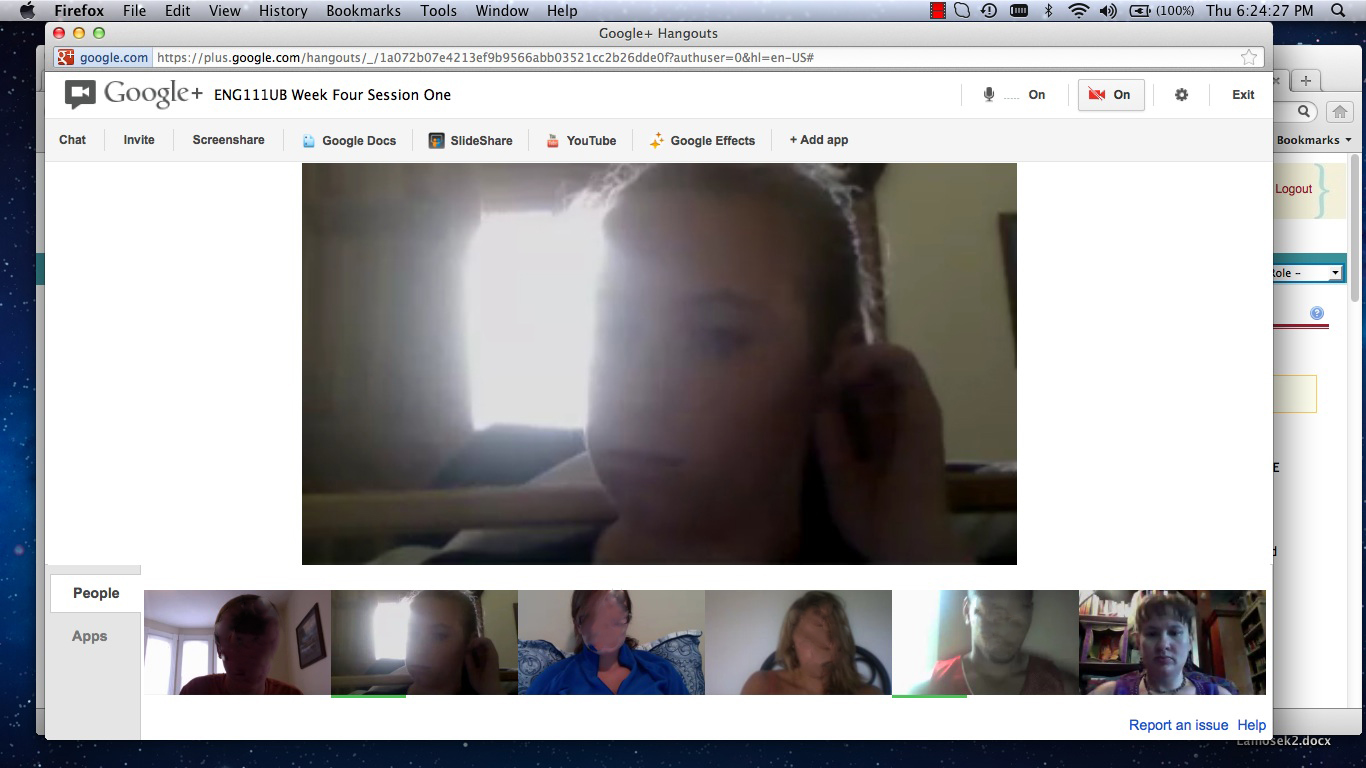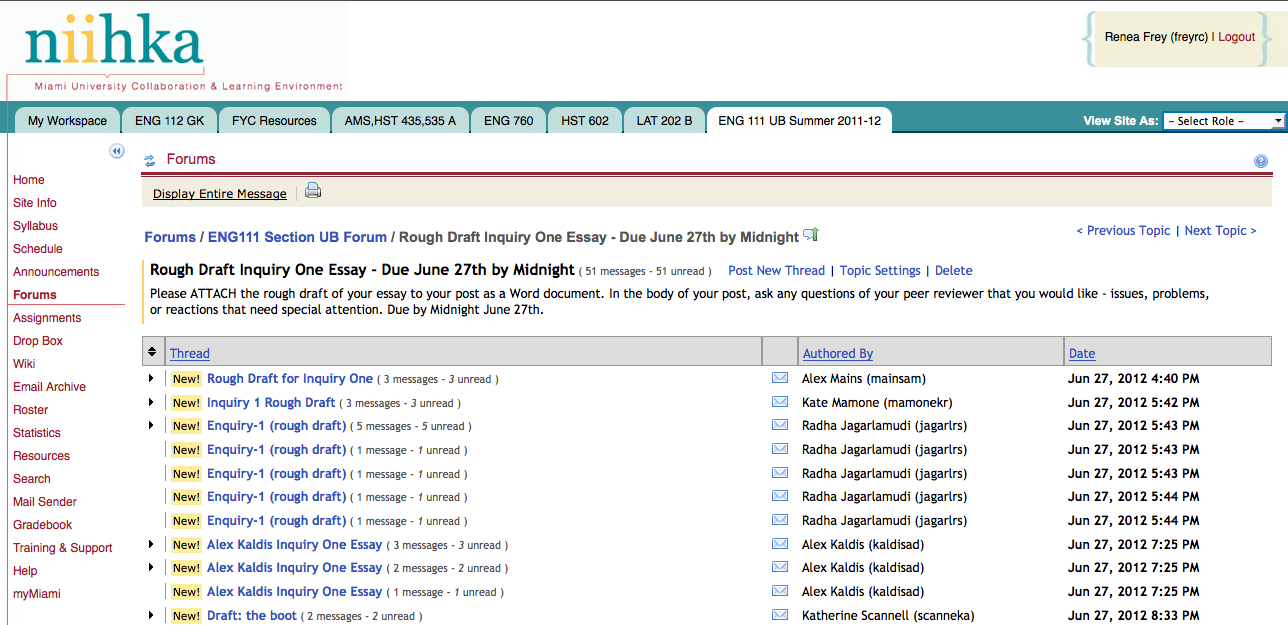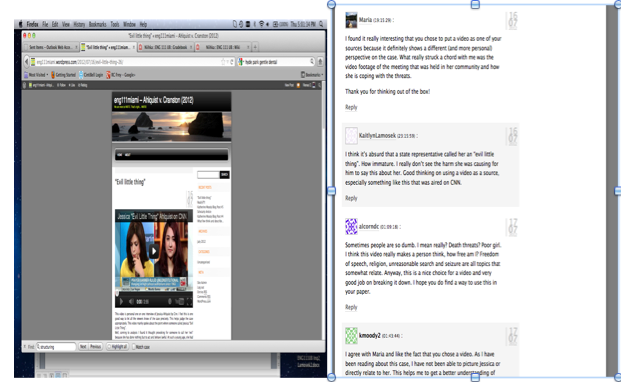Kairotic Design: Building Flexible Networks for Online Composition
Making Space for Collaboration (Renea)
Regardless of pedagogical stance or teaching goals, the spatial constraints of a physical classroom affect the ways that instructors are able to enact pedagogies or meet goals once the class convenes and interacts within that space. For those wishing to enact a pedagogy based upon collaboration and student interaction, facing a room with heavy or immobile desks formed neatly into rows, or small, confined spaces within which free movement is cumbersome or impossible, may serve as an obstacle to enacting these practices within the classroom. As noted by Amanda Bemer, Ryan Moeller, and Cheryl Ball (2009), "Student interaction is affected by the physical space of a room just as much as it is influenced by the presence of a teacher or the technology" (140), though, as they further suggested, this is also an aspect of the teaching environment over which instructors often have little control. Although certainly instructors work creatively to subvert the nineteenth-century classroom model, both spatially and pedagogically, many brick-and-mortar teaching spaces are still designed after the "banking method" of education, where the instructor is at the front and center of the room, consciously and spatially directing the learning taking place.
When faced with the possibility of teaching an online writing course, I wondered how space might be imagined differently so that collaboration and student interaction would have a more central location within it. How might I step away from the front of the class to allow for more networked agency among student participants? How could I plan the class while still leaving space to design parts of the course kairotically, to reflect the students' work and concerns in the moment? Was it possible to foster these goals in an online course? In a condensed six-week term?
Networked Design
My goal was to create a space that balanced the need for sharing information with students while still supporting a distributed network approach to learning that encouraged collaboration, and also being flexible in the design of the course so that I could alter what we were doing or discussing based upon student writing and needs. The space provided by Google Hangouts allowed for a visual representation of the networked space comprised of multiple participants that I envisioned, rather than a conventional classroom space where students and instructor are clearly defined by their placement within the space provided. We met in the Google Hangout space each week in small, synchronous groups, to discuss the assigned readings, to discuss the video lectures viewed prior to our hangouts, and also to write together. This space also provided the most flexible site of kairotic design and invention, as the content of our class meetings would be largely determined by the writing the students were doing, topics from that week's assignments, and questions or concerns raised by students either during the Hangout itself or previously in emails. These were "open spaces" in our schedule, the content of which would not be determined until shortly before the meeting, thus allowing for in-the-moment instructional choices driven by the students and their writing.
Additionally, the space afforded by the Google Hangouts interface allowed me to be viewed as one of the participants, rather than over-privileging my position within, or at the front of, the classroom, as I was just "one of the speakers" present from a visual perspective: In the Google Hangout space, each participant “takes turns” being shown on the large, central screen, though participants can click on one speaker to be in that position if they choose; see figure 7.5. Sometimes my image was front and center, but sometimes it was not, and participants had the ability to make choices about this. This space allowed for a more direct visual representation of the distributed network model that I hoped to engender, and moved away from the nineteenth-century model where my voice, and my image, would be front and center for all other participants, regardless of their preference.

Figure 7.5. Screenshot of Google Hangout
When writing together during our asynchronous class meetings, I also experimented with "blacking out" my image from the hangouts space so that, hopefully, students would feel less watched while they were writing. Although I am unsure how students perceived my "blank image" during these exercises, I myself was acutely aware of my own presence within the space prior to "disappearing" my image from within it. Unlike a conventional classroom space where the presence of the instructor is an assumed figure within it at all times, in the Google Hangouts space, I was very aware of myself as an overseeing, non-participating entity while students were writing, and thus removed my visual representation as much as possible. Uncomfortable with the role of overseeing non-participant, on my own screen, I would often "cover" the Google Hangouts window with another document or site, sometimes preparing for the next part of the discussion, while students were working together.
Inquiry Groups
To build collaborative, networked practices into the course, I experimented with the invention of inquiry groups; each group consisted of two or three students working on similar topics. My goals in structuring the course in this way were to (1) provide a logical progression from one project into the next and (2) encourage students to interact more with one another to promote community, peer-supported learning, and collaborative writing skills, but (3) introduce students to this collaborative/networked aspect of the course over a period of time, allowing students to become more familiar and comfortable with one another before having to work in a wholly collaborative manner.
For the first project, which was the most independently composed, we used the Niihka Forum (see figure 7.6) as the primary space for posting and sharing work. Although this gave access to all documents to all students, the linear format of Niihka made truly networked interaction difficult, and lent itself to a more conventional arrangement of posting and responding specifically and only to very particular parties. The format of Niihka makes it difficult to alter or use in any other manner and is reminiscent of the way a traditional classroom would be designed. The instructor chooses topics, sets up forum threads, and students individually post responses in neat, linear rows. This setup, while not terribly conducive to a more networked approach, was one with which many students were already familiar, and was, at times, the most expedient interface to use for some assignments, such as garnering individual responses to readings or videos.

Figure 7.6. Niihka forum discussion board
While the Niihka Forum was useful for turning in or sharing some types of assignments, other spaces—such as blogs—were more conducive for wider interaction. Thus, in the next project, students compiled group blogs and commented on each other's work in a less linear and more networked way than afforded by Niihka. When it came time to write the major research paper, they had a group of peers who were already well informed about the topic, and with whom they were already accustomed to working. Students reported in their reflective documents that the research blogs and resultant comments allowed them to think about their topics in novel ways, and that the feedback from community members gave them a greater awareness of writing to an audience that was actually responding to the work that they were doing.

Figure 7. Student research blogs and comments
By commenting upon each other's work in various online spaces—through discussion forum posts, comments on research blogs, and live Google Hangouts sessions—students were able to talk about what they were working on and gain different perspectives from a knowledgeable audience. Each of these spaces offered its own constraints and affordances that ranged from the more conventional/linear model of the Niihka Forum, to greater access and networked interaction through blogs, to the de-centered conversation available in Google Hangouts. I found that each space was useful for particular types of activities, though the more I moved away from linear spaces such as Niihka, the greater the opportunity for student to student interaction and networked learning that I hoped to engender.
Inquiry groups were eventually required to produce a wholly collaborative video project where they presented multiple sides of a controversial topic in the form of a mock talk show. Students chose times and online spaces most conducive to their work when and where I was not present at all. This project also required collaborative writing, producing one document to which all students in the group contributed. For this, most of the groups chose to use Google Docs so that all members could see, edit, and comment upon the draft in progress before deciding upon a final version to turn in for a grade, after which they composed video projects with free screen-capture software while they performed their "talk show" scripts in Google Hangouts. The video projects, while often not technically polished, were generally rhetorically savvy and demonstrated the students’ understanding of audience, purpose, and medium, thus meeting the course outcomes set for the English 111 class.
(Virtual) Collaborative Space: Affordances and Constraints
Perhaps the most satisfying (and not wholly expected) aspect of utilizing the inquiry groups in an on-line space was the de-centering effect that it had upon my presence in the class. In a traditional class, even when students work together in peer groups, the instructor is still present, a surveilling force of authority, even if that effect is not intended. While at times, such as in the synchronous Google Hangouts meetings, I was in the space with the students, I was not as visually "central" as I would be in a conventional traditional classroom. By using the video lectures as artifacts that could be viewed prior to our class meetings, the hangouts allowed me to become more of a participant and less of a totalizing force within the space, as well as to give space to design our class meetings kairotically depending upon student writing and needs.
In the online inquiry groups, students often met and interacted in their own virtual spaces free from my gaze, such as in their own Google Hangouts, conducted at times and within meeting spaces to which I was not invited. What I saw were the products and traces of those interactions, rather than "overhearing" or "eavesdropping" on them as I would in a traditional classroom where most of the work on their collaborative projects is conducted during class time. This aspect of my periodic absence in the class-space allowed for the possibility of more candid or open interaction between the students, though of course I was only an email or Google Hangout away if they ran into problems or had questions.
Although the online space allowed for a more distributed network approach to the learning environment than I have found possible in traditional courses, the amount of agency and collaboration afforded to students in this configuration should also not be overstated. Students had to make choices within bounds set by me and by the institution (such as the possible controversies they might study) and were still bound to a set of rules and regulatory practices (such as attendance policies and assignment completion schedules). There were also times that I hoped for more student interaction, discussion, or "taking over" of our class meetings, and though this occurred at times, it did seem as though students often awaited my cues just as they would in a conventional physical classroom. Thus, though the material space within which learning occurs certainly affects the way that a course is conducted, as well as the possibilities for student interaction and collaboration, most students have been conditioned to a particular set of expectations of authority and hierarchy that cannot be overcome immediately simply by redefining, expanding, or restructuring the space.
There were also drawbacks similar to those that might be faced in a conventional classroom, although because this was an online course, it was difficult to ascertain if the issues would have been more resolvable had live interaction occurred. As often is the case in traditional courses, there were a couple of students who did not keep up with the work and who did not interface with the rest of the class via Google Hangouts, though not for technical reasons. It is difficult to say whether this would have been different in a traditional class (for instance, the students may have opted to skip class and not respond to emails), or if the interface itself was in some way alienating or difficult to navigate. Although most students who signed up for the course seemed comfortable interacting in the online environment, it is not necessarily a space that is equally comfortable or accessible to all.
Moving Away from Desks in Rows
I know from feedback and reflections from several students that they seemed to form meaningful friendships in their inquiry groups during the six-week term, and many of them were looking forward to meeting "in real life" once they were all on campus. The online spatial affordances, far from putting me "more in the center" as I had feared, actually allowed me to say my piece via the video lectures and then back away, giving more space for student ideas, writing, and interaction. Although many students reported feeling uncertain of how well this would go (and indeed I, too, had my doubts at the beginning), in the end most reported that the experience was positive and helped them foster relationships with their peers that would extend beyond the course. This combination of skills-based confidence and social connection is always my hope for traditional courses, and yet it was in the online venue that students directly reported having met these outcomes.
Although in the summer online composition course we had a slightly lower enrollment cap (eighteen) than would be typical for a regular-session course, the concept of inquiry groups could certainly be applied in other contexts and with variably sized classes. It might be possible to foster more collaboration and a sense of networked agency within the space of the virtual class by creating scaffolded projects that require increasing degrees of collaborative effort to produce. In addition, creating spaces outside of the teacher–student interactive dynamic may promote more networked learning that is not directly "overseen" by a regulatory authority figure, which may encourage more open discussion, social learning, and peer-centered dialogue. In traditional courses, interaction without an instructor present requires students to meet outside of class, typically in physical locations, but the virtual space of the online class may allow for greater flexibility and types of spaces (email, Skype, Google Hangouts, chat, etc.) where students can interact in ways comfortable and conducive to their schedules and interactive styles. In this case, the virtual space of the online composition class, rather than wholly reproducing the dynamics of the conventional classroom, actually provided the ability to move somewhat "beyond the walls" of traditional power dynamics so that students might more fully engage with one another on their own terms, rather than shape their discussion and writing processes to those perceived as preferable by the instructor.
